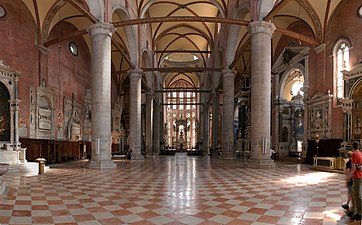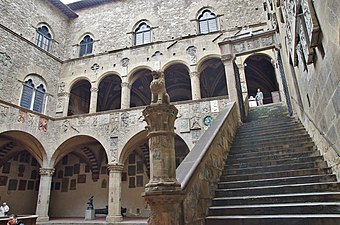Italian Gothic architecture
Gothic architecture appeared in the prosperous independent city-states of Italy in the 12th century, at the same time as it appeared in Northern Europe. In fact, unlike in other regions of Europe, it did not replace Romanesque architecture, and Italian architects were not very influenced by it. However, each city developed its own particular variations of the style.[1]
Years active
12th to 15th century
Italian architects preferred to keep the traditional construction methods established in the previous centuries; architectural solutions and technical innovations of French Gothic were seldom used. Soaring height was less important than in Northern Europe. Brick rather than stone was in many areas the most common building material, and marble was widely used for decoration.[2] In the 15th century, when the Gothic style dominated both Northern Europe and the Italian Peninsula, Northern Italy became the birthplace of Renaissance architecture.[1]
The Gothic style was first introduced into Italy in the 12th century by monks of the Cistercian and Franciscan Orders. The Cistercian order was founded in France in 1098 as a breakaway from the Benedictine Order, which the Cistercians considered too lax. The Cistercians were determined to follow more strictly the Rule of Saint Benedict. They built austere churches, first in the Romanesque style and then with Gothic features, but with a complete absence of decoration. The Cistercians banned any form of art, sculpture, or stained glass. Bell towers were absent or very simple. Nothing was permitted that did not have an essential practical purpose. These churches were usually far from the centre of cities. The first Gothic structures in Italy were the Cistercian churches of Fossanova Abbey and Casamari Abbey, built on the model of the Cistercian churches in the Duchy of Burgundy, particularly the original Cistercian church, Citeaux Abbey.[3] Casamari was originally built as a Benedictine church, but was rebuilt entirely to meet the standards of simplicity and austerity of the Cistercians.[1] The Cistercians built several churches throughout the Italian Peninsula, mostly in the countryside. They went as far as Sicily, where they constructed the unfinished basilica of Morpurgo near Lentini in the Province of Syracuse, begun in 1225.[4]
The spread of the French style of Gothic introduced by the Cistercians was resisted by the hierarchy of the Catholic Church in Rome, which preferred a return to the earlier style of architecture under Constantine the Great and of the Byzantine Empire. The first Gothic church in Rome, Santa Maria sopra Minerva, a Dominican church, was a copy of Santa Maria Novella in Florence, and was not begun until 1280.[4]
The Franciscans were founded by Saint Francis of Assisi in 1208. Their doctrine called for reaching out to the general population with their message, which meant constructing churches with large naves without any visual obstacles for preaching sermons to large congregations. Unlike Cistercian churches, they welcomed art in their architecture. The upper parts of their first major church, the Basilica of San Francesco of Assisi (1228–1253) were decorated with colourful murals by Cimabue depicting the lives of the Saints.[1] The Basilica was in the form of a simple Latin cross, and had none of the aspirations to great height of the French Gothic style. It was built of brick, covered with plaster on the inside. The stained glass windows were reduced in size, simple and colourless. [5]
The Franciscans constructed another important church, San Francesco, Bologna, in (1236–30), which was closer to the French Gothic model. It was built of red brick, beginning a tradition in Bologna architecture that lasted for two centuries. The facade was similar to those of Romanesque churches, but inside it had a more Gothic form, with aisles, an ambulatory with radiating chapels, and flying buttresses. Other important early buildings included the Parma Baptistery by Benedetto Antelami and the Basilica di Sant'Andrea in Vercelli, which showed Antelami's influence.
Siena Cathedral (1215–1263) begun in the mid-13th century, is another major landmark church of early Italian Gothic. Its interior is a mixture of Gothic and Romanesque elements, such as the domed crossing tower, and horizontal banding of the interior columns with polychrome marble. The most striking and original Gothic feature is the decorated screen facade on the west end, with sculptural decoration designed and partly carved by Giovanni Pisano in 1284–1320.[6]
Mature or High Italian Gothic (14th century)[edit]
Florence Cathedral[edit]
A number of major Italian Gothic buildings were begun in the late 13th century and completed in the 14th. Florence Cathedral, designed by Arnolfo di Cambio, was begun in 1296. It is not exceptionally high, but the interior has a sense of spaciousness created by the merger of the nave and the aisles. The work proceeded very slowly. The campanile, designed by Giotto, was begun in 1334. Work continued after Giotto's death in 1337, first under Andrea Pisani and then, in the 1350s, by Francesco Talenti. The campanile is square and decorated in marble with rectilinear panelling, and follows the Italian Romanesque tradition. It was largely modelled after the older baptistery (1060–1150).[6]
The Cathedral plans were modified between 1357 and 1360 by several committees of painters, sculptors and artists, giving priority to the decoration. The City of Florence took it very seriously as a civic monument, financing it with a tax upon all the male inhabitants of the city, and even lowering the level of the streets around it so it would be more visible. A modified new plan adopted in 1366 called for a massive dome, as wide as the combined nave and aisles, on an octagonal base with three apses. The technical problems of building such a large dome were not solved until the 15th century with a new plan by Brunelleschi.[6] The rather plain original facade was demolished to construct the dome; the present facade was not built until the 19th century. The east end of the cathedral largely retains its original Gothic architecture.
The 14th and 15th centuries saw the construction of a series of new churches in the Venetian Gothic style, including the church of the Franciscans, Santa Maria Gloriosa dei Frari, begun in 1340. Built of brick, it featured three naves and an apse with six radiating chapels, and rib vaulting that sprang from massive cylindrical columns.[11] The Dominicans also built a new church, Santi Giovanni e Paolo (15th century), with three naves separated by columns, and Gothic capitals, arches and decoration. A fire in 1419 badly damaged St Mark's Basilica, requiring the construction of a new south facade. It was richly decorated with an assortment of Gothic pinnacles and tabernacles.[11]
The most original examples of Venetian Gothic were not the churches, but the palatial residences built for the Venetian aristocrats and merchants, The Venetian Republic achieved a peak of prosperity in the 15th century, especially after the fall of the Byzantine Empire in 1453, which made Venice the trading hub for the Eastern Mediterranean. [11] The Doge's Palace, begun in the mid-14th century but greatly expanded in the 1420s, contained the Doge's apartments, council chambers, law courts, a prison, and the meeting hall for the lower house of the Venetian parliament. The ground and first floor had a double colonnade, while the upper floors were decorated with white and pink marble in delicate geometric designs.[12]
Major examples of aristocratic residences include Palazzo Pisani and Palazzo Foscari, but the best-known example is Ca' d'Oro, or "House of Gold", built between 1421 and 1444 for Marco Contarini. It featured a portico and double gallery that were originally gilded, giving the palace its name. [11]
Beginning in the second half of the 13th century, Italy produced more examples of secular Gothic architecture than other parts of Europe. The buildings were frequently constructed by the Capitano del Populo of each city, an organization that represented the guilds and the wealthy merchants of the city. Major examples included the Capitano del Popolo in Orvieto, the Palazzo Communale at Piacenza, and the massive Palazzo del Capitano, or Bargello, in Florence.[9] Other Major examples are found in Siena, Florence and Venice. They illustrated the importance of Italian cities as banking centres, and increasing civic pride. These buildings were open to the exterior, with ground-floor loggias, large upper windows, balconies, and outside staircases, and frequently had large halls that were decorated with fresco painting.[9]
Another notable example of Gothic city planning is the fan-shaped Campo, or town square, in Siena, which is dominated by the Palazzo Publico (1298–1348) and the Torre della Mangia, the tallest municipal tower in Italy. Florence constructed a similar municipal palace, the Palazzo Vecchio (1299–1310), though it retained many of the features of a fortress. A major example of a private Florentine palace is the Loggia della Signoria (1370s), next to the Palazzo Vecchio, whose round arches and roofline suggest the coming Renaissance.[12]
In the Kingdom of Sicily at the beginning of the 13th century, an important civil and military construction programme was promoted by the Sicilian king, Frederick II, who was Holy Roman Emperor and through his mother Constance, Queen of Sicily grandson of the great Norman king Roger II of Sicily. The Emperor called upon the architects and craftsmen who had built the Cistercian monasteries to build castles and fortifications. The most important works include the Castel del Monte in Apulia and the Castello Maniace protecting the harbour of Syracuse, Italy.[4]
















